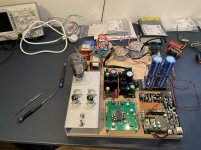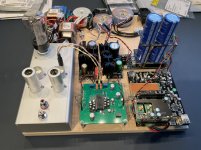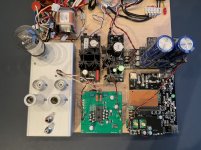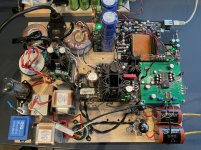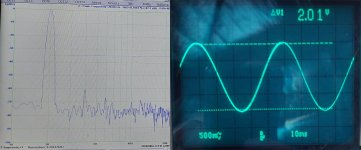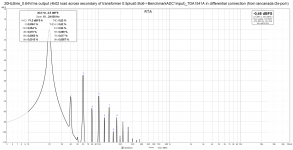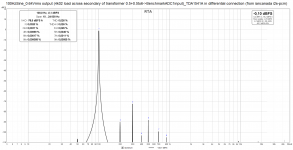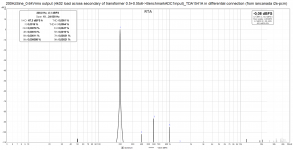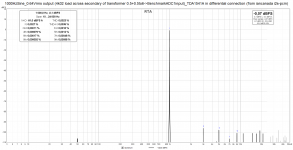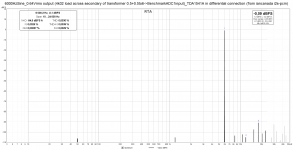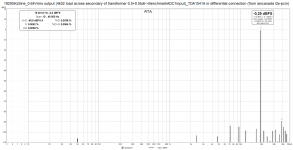Does everyone have my build guide?
I only know your "ryanj “D3” Tda1541 board population guide". It helped a lot to solder this thing, thank you very much for your work. It runs perfectly and sounds great. I was using it for months but more of a "free air" approach only using a MDF board for mounting. The transformers had very big distances there and also didnt influence each other.
Now that i move the whole thing into a much more space limited case my question is only about the transformer orientation. How to mount them best.
Or is there a build guide with PSU recommendations ? I use Ryans 26V PSU, but with on board transformer and a EC Designs charge transfer PSU for 5V.
The others in the background are 6.3V for the tube heaters and a 120V transformer that will be used without PCB (But it also have a metal screen for it going to GND).
Last edited:
Yes thanks for creating it. Answered a lot of questions and encouraged me to practice soldering a 4 layer board before jumping in with the final parts.Does everyone have my build guide?
I'm no expert. I believe that you should avoid having two close together in the same orientation. I think A looks good. Each is separated by an inch or 2 and seem to be rotated 90 degrees from it's neighbor. You can also set them in place and power them. If they are coupling, they'll make a fair bit of mechanical hum. I did that in my first layout with a couple of Hammond 229 transformers side by side and they let me know.Hi,
after a very long time on a MDF board my D3 will receive a case. I bought a Linn Intersekt case for very little money and now mod it to my needs.
My question is : Which way to mount the PSUs would you prefer and why ? Is there a difference if the transformers are side by side, facing away from each other or even one on the floor one on the wall ? Which would make sense ? Here are my possibilities.
I defer to Ryan. FWIW, I believe I've seen this asked a few times as I reread the thread. I believe the answer is Ryan designed & tested at 26V. He recommends from that up to max 28. He says that below 25.5V it might not perform as well as he tested.
I plan to use my existing supply that runs around 25V.
Thanks Walter!
I have a transformer that puts out 20v or one that does 32v. The 20v is a tad on the low side (note that I use mosfet rectifiers that have very low voltage drop) and the 32v is quite high and heats up the Ultrabib too much.
This is my latest bread board approach, still in development.
The tube output stage is currently an SRPP but I intend to build a second D3 and go differential so I already added 2 extra tubes.
Still looking for a nice schematic though. Maybe a differential Aikido?
Attachments
I see a lot of good stuff in that photo. This will sound sweet.
Cool layout with the I2StoPCM board under the D3! I would not have thought of that. I'll keep that in mind for the future. I somehow failed on assembly/debug of Ryan's I2StoPCM. I am thinking for now will revert to I2S input from Reclockpi.
Nice job!
Cool layout with the I2StoPCM board under the D3! I would not have thought of that. I'll keep that in mind for the future. I somehow failed on assembly/debug of Ryan's I2StoPCM. I am thinking for now will revert to I2S input from Reclockpi.
Nice job!
I changed to the 32v transfo and the mosfet rectifier with diodes for some extra voltage drop (too bad I get the switching diode noise back🙁) and adjusted the voltage output to 27,5v. In this way the heat of the regulator stays just under the limit.
Attached is my previous mess in comparison to the current layout.
It is playing now but there is too little bass and a grounding problem so it is not finished yet.
@wlowes: too bad you cannot get the i2s-pcm board working, it does great things for the sound!
Attached is my previous mess in comparison to the current layout.
It is playing now but there is too little bass and a grounding problem so it is not finished yet.
@wlowes: too bad you cannot get the i2s-pcm board working, it does great things for the sound!
Attachments
Last edited:
Looks good Supersurfer.
But Dang! I wish you had not mentioned I2StoPCM. I had just convinced myself I don't need it. 🙂
But Dang! I wish you had not mentioned I2StoPCM. I had just convinced myself I don't need it. 🙂
I have collected all the parts and will start soldering in a week or so. I am debugging some irritating issues with my current system and I want a working benchmark to before I rip apart everything to accommodate D3.
Then give me the strength to nail down the top of the chassis and stop tinkering with this thing and just enjoy the music. These systems are becoming stupid good. I'd like to consider it done and move on to focus on collecting really good music that has been recorded on a system that is at least as good as these things we are building in our basements.
Then give me the strength to nail down the top of the chassis and stop tinkering with this thing and just enjoy the music. These systems are becoming stupid good. I'd like to consider it done and move on to focus on collecting really good music that has been recorded on a system that is at least as good as these things we are building in our basements.
Last edited:
Hi Ryan,
What is your experience with output transformers? I read you have used a Lundahl and a Bisesik. How do they compare?
What is your experience with output transformers? I read you have used a Lundahl and a Bisesik. How do they compare?
Hi Ryan,
What is your experience with output transformers? I read you have used a Lundahl and a Bisesik. How do they compare?
So far I like the sound most from the Sowter 1465 in differential mode.
I tested two different sets of Bisesik's transformers with different ratios. They both performed roughly the same in terms of THD, but I think the lower ratio ones sounded slightly better to me - I think it was 1:6 and the other was 1:22. These transformers seem to perform very well in the higher frequency range compared to the Sowters. The Sowters seem to limit frequency bandwidth past 20k so filter out the high frequency hash when running NOS 44.1k.
When I tested THD with at 20hz the Sowters outperformed Bisesik's, ill attach some pics of the results. Please take the results with a grain of salt as my test setup is far from optimal, but you can at least get an idea of the difference between the two. In my opinion the results do corelate to my listening experience.
Attachments
Interesting to hear your transformer I/V experiences Ryan. Did you play around with the I/V resistor values too? I guess they have a similar relationship in effect to an active I/V?
Interesting to hear your transformer I/V experiences Ryan. Did you play around with the I/V resistor values too? I guess they have a similar relationship in effect to an active I/V?
Yes I tried a few different IV resistor scenarios but ended up having the iv resistor on the secondary side - but now it is really called a load resistor as the iv conversion is now done by the transformer, the exact value I cant remember but it keeps the load as seen by the 1541A under 65R. Also when using a load resistor on the secondary the quality of the resistor is much less important, so one can easily use a pot and adjust to achieve lowest distortion/amount of gain needed. Although - once im totally happy with the load resistor value I will replace it with a good quality one.
So far I like the sound most from the Sowter 1465 in differential mode.
I tested two different sets of Bisesik's transformers with different ratios. They both performed roughly the same in terms of THD, but I think the lower ratio ones sounded slightly better to me - I think it was 1:6 and the other was 1:22. These transformers seem to perform very well in the higher frequency range compared to the Sowters. The Sowters seem to limit frequency bandwidth past 20k so filter out the high frequency hash when running NOS 44.1k.
When I tested THD with at 20hz the Sowters outperformed Bisesik's, ill attach some pics of the results. Please take the results with a grain of salt as my test setup is far from optimal, but you can at least get an idea of the difference between the two. In my opinion the results do corelate to my listening experience.
Thank you for your explanation. If I read it correctly you prefer the Sowter due to the lower bandwith thus filtering HF noise. Am I correct?
According to your experience the bandwith of the Sowters seem to be targeted a tad lower than the Bisesik: less bass distortion (does this also mean more base extension?) but also less high frequencies from Sowter.
I use a tube amplifier with no less than 4 signal transformers (volume trans 2x interstage and output trans) so in my case I guess the HF noise is pretty well filtered.
I need good bass extension. How do they compare subjectively in the low frequencies?
Ryan, have you shot the THD for 1kHz and HF?
Yes, it was a similar distortion profile with H3 at about -32dBr.
Thank you for your explanation. If I read it correctly you prefer the Sowter due to the lower bandwith thus filtering HF noise. Am I correct?
According to your experience the bandwith of the Sowters seem to be targeted a tad lower than the Bisesik: less bass distortion (does this also mean more base extension?) but also less high frequencies from Sowter.
I use a tube amplifier with no less than 4 signal transformers (volume trans 2x interstage and output trans) so in my case I guess the HF noise is pretty well filtered.
I need good bass extension. How do they compare subjectively in the low frequencies?
To my ears both transformers sound very clean in the highs. Im not totally sure I can hear the filtering effect with the Sowters. I prefer the bass with the Sowters - I cant fault them, bass has great extension and is very controlled. The only way I could get Ivans transformers to sound good in the bass was to run them at about .39V RMS which was just not enough gain in my system. Unfortunately even when running them at this level I still prefer the Sowters.
- Home
- Group Buys
- DIY TDA1541A PCB "D3"
